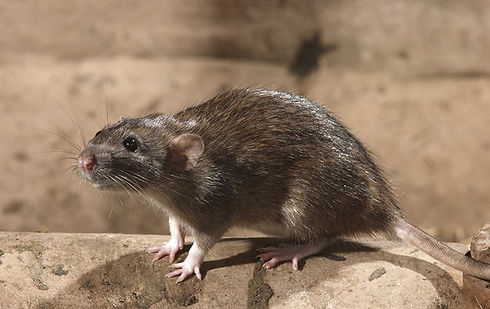RODENTS
NORWAY / BROWN RAT

ROOF RAT
Roof rats live in colonies and prefer to nest in the upper parts of buildings. As climbers, roof rats are more likely to cause structural damage in homes as they chew on wood and wires. They can also be found under, in and around structures. Unlike Norway rats, their tails are longer than their heads and bodies combined. They have large ears and eyes (typically larger than those of the Norway rat) and have a pointed nose. Roof rats can also carry fleas and spread diseases such as typhus via fleas, infectious jaundice via urine in water or food, rat-bite fever via bites, trichinosis via undercooked pork and salmonellosis via droppings. Additionally, these rodents can cause food poisoning by contaminating food or food preparation surfaces.

HOUSE MICE
There are two main things that can attract mice and rats to your house. Food and shelter. If you don't tidy up properly and there's food waste on the floor or surfaces, rodents are going to love it! Rats and mice also need shelter, particularly during winter to avoid the worst of the cold. A female house mouse can give birth when they are only two months old, and they are able to have to up to a dozen babies every three weeks. This means she could have as many as 150 offspring in a single year!

FIELD MICE / DEER MICE
Deer mice are nocturnal but are occasionally active in the early evening. They spend daylight hours in burrows or in trees, where they construct nests of plant material. Although terrestrial, they are agile climbers. Being the great climbers that they are makes it easy for then to break into a home. Weeping holes, AC lines and plumbing are just a few ways they can enter. Their diet includes everything from plant products and fungi to invertebrates and carrion.

VOLES
Voles are rodents that resemble mice, although they are stouter, and have longer hair and shorter tails. In terms of damage done to your garden, voles are the real culprit. Voles eat plant roots, bulbs and the bark of young trees (especially fruit trees). Like mice and other rodents, voles can get out of hand if not managed properly. If you see that you're starting to have a problem, it's better to deal with it before the pest population becomes so overwhelming that it’s impossible to control.

MOLES
Moles are insectivores, eating 70-100% of their weight in worms, grubs and insects each day. In order to hunt down their ground-dwelling prey, moles constantly excavate, leaving behind a series of tunnels. This digging requires a tremendous amount of energy, which may explain the mole's voracious appetite. Some homeowners find moles beneficial because they prey on many destructive insects and their digging helps to aerate the soil. However, many feel that the damage moles cause to their lawns outweigh any benefits they provide. Most people think that is moles causing the damage to their property but most of the time the voles are the real problem.

.png)


